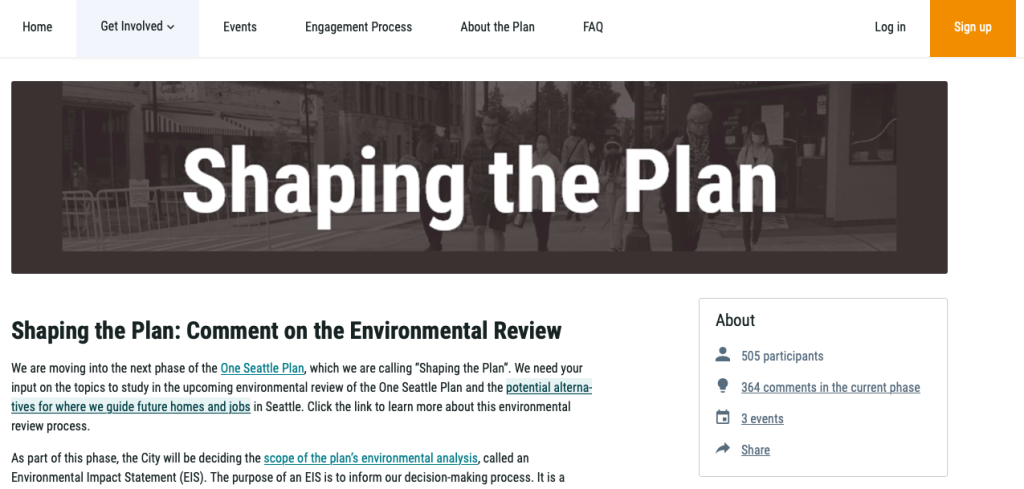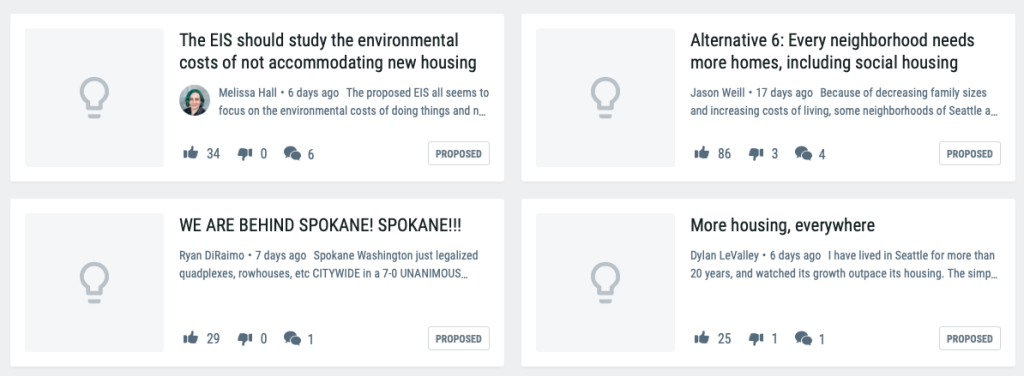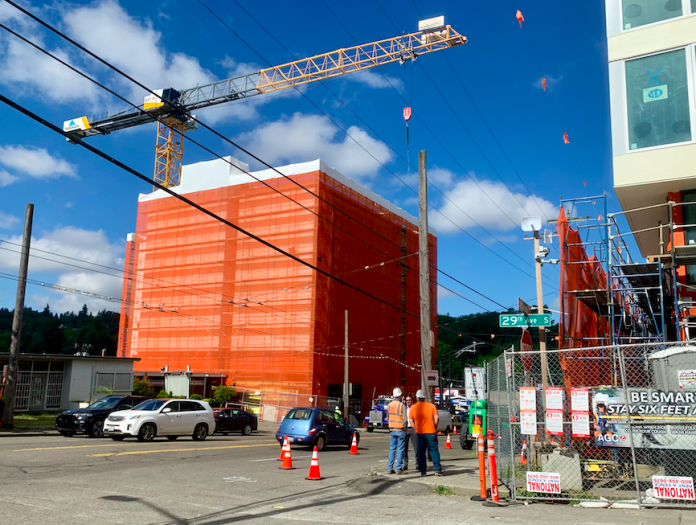The Urbanist has reported on the rezoning concepts unveiled for Seattle’s 2024 Major Comprehensive Plan Update, which will guide growth in the city for decades to come. We’ve also published an op-ed by contributor Ryan DiRaimo arguing that the City of Seattle should be setting higher housing growth targets and extending its planning horizon farther into the future to avoid coming up short on housing as has happened in the past. Now we want to share with readers how to provide public comment on the Comprehensive Plan at a critical moment in its development.
At this point, if you visit the One Seattle Plan Engagement Hub about 500 participants have provided 362 comments on the current scoping phase. In a growing city of over 762,000 residents, that number represents a tiny drop in an ocean of Seattleites. This means that what you write is likely to be read — and taken into consideration — by key policymakers. The old adage that the squeaky wheel gets the grease will apply in this case, as it has so many times in the past.
Comments on the current “Shaping the Plan” phase will be accepted by midnight, August 22nd, meaning that even if the whole idea of a Comprehensive Plan Update is still new to you, you have time to get up to speed and spread the words to others who care about Seattle’s future.
Step 1: Learn about the plan and process
Don’t despair if this whole Major Comprehensive Plan Update sounds foreign and strange to you — the City of Seattle has put in extra effort to helping the public understand plan and engage with the process. If you find overviews helpful, a good place to start is a six minute video created by OPCD that explains what a Comprehensive Plan is, why it matters, and how you can get involved.
For those who prefer text over video resources, there is also a fact sheet available that lays out the basics around the plan.
One Seattle Plane is Scoping Fact Sheet by Natalie Bicknell on Scribd
Once you feel you understand the nuts and bolts, take some time to mull over Urbanist Executive Director Doug Trumm’s article on the Comprehensive Plan Update alternatives, which in addition to outlining the five growth alternatives being studied, provides an urbanist’s assessment of what strategies should be added in this scoping phase. It’s a great way to get thinking about what parts of the plan you want to provide comment on and what you might want to say.
Long story short, the “Combined” Alternative 5 is the best of what’s proposed so far, but we should also be asking for improvements to each alternative. For example, Trumm suggested the “Focused” Alternative 2 should study adding high-rise and mid-rise housing, the “Broad” Alternative 3 should study adding sixplexes, rowhouses, stacked flats, and courtyard apartments to Neighborhood Residential zones, the “Corridor” Alternative 4 should add density in a wider 15-minute walkshed of transit stops, and the “Combined” Alternative 5 should incorporate all of those improvements. You should also feel empowered to propose a new Alternative 6 if your ideas to add housing options go beyond this framework.
Need some help thinking of what you want to share in your written comments? There are many resources available on how to provide effective public comments available online, but here are some top tips:
- Keep comments brief for maximum impact;
- Use simple and direct language;
- Use personal and/or specific examples to illustrate your points;
- When possible, add something new to the conversation;
- Use data to back up your points, if available.
We are currently in the first part of the “Shaping the Plan” phase, meaning the feedback that OPCD receives now will set the tempo for what kinds of actions will be studied, and eventually taken, while the next part will bring an additional round of public feedback that will refine the concepts that will be studied. Thus making a lot of noise right now will have an outsized impact on the entire trajectory of the process. If OPCD does not hear from the public that they want ambitious plans for adding housing to be studied, they won’t do it. And if bolder ideas don’t make it in during this scoping phase, OPCD won’t be able to add them into contention at a later phase because the agency will not have done the analysis needed for the required Environmental Impact Statement.

If you like to attend events and learn in person, mark August 14th, 2022, on your calendar. On that date, OPCD staff will be attending the Othello International Festival and providing information about the Comprehensive Plan Update with the option submit comments on-site. It will a great way to enjoy food and culture from across the globe and learn about the City’s plans!
Step 2: Get familiar with the Engagement Hub
For most people, the Engagement Hub will be the primary way to share comments. The first step will be to sign up for an account. You can do so by clicking on the orange box in the upper right corner of the Get Involved page. Then you’ll be asked some basic demographic information. Selecting an avatar and providing more personal information is also an option.

Once you have created an account, you can read other people’s comments and submit your own. You can also comment on other people’s comments as well. As you will see, some lively discussion takes place in the comment subthreads.

If this feels a bit free form, well it is! That’s why it’s important to be familiar with the plan and what you want to share before diving in.
It’s also important to point out there while the “Shaping the Plan” is the primary area the City is accepting comments on, it’s also comment on other topics like centering equity or the phase one survey results. You can also submit a general comments. These options are all available on the Engagement Hub page.
Why should I comment on the Comprehensive Plan Update?
At this point, you might still be thinking — why me? Do I really need to comment on the Comprehensive Plan Update? Will what I have to say actually make a difference? Well, the answer to both of those questions is yes, particularly if you want to see Seattle become a denser, more affordable, more walkable city to live in. Unless a vocal segment of the public rises up calling for change, it is generally easier for the political establishment to maintain the status quo — thus, people defending it usually need to put forth less time and energy into advocating for their cause.
In this case, that means it will be easier for people who argue in favor of minimal zoning changes to prevail in the planning process — even if the affordability and environmental consequences of reserving over two-thirds of Seattle’s residential land for single-family home development are well understood.
Why is it so easy to maintain a system that’s obviously failing? Well, in addition to political ease, defenders of the status quo are also helped by the fact many — if not all — of the systems in place protect it by default.
When we consider the Comprehensive Plan Update, it is simply going to be easier for the City of Seattle to back away from ambitious zoning changes, than it will be to enact them. So if we to see a denser, more affordable, more sustainable future for Seattle, we will have to make it clear that it what residents both need — and want.
If you find the possibility of participating in the Comprehensive Plan Update process exciting, and we hope you do, then get engaged — and while you’re at it, take a few minutes to comment on the Seattle Transportation Plan as well. This is such a critical — and exciting — time in Seattle’s development. Let’s do all we can to make sure the city grows in a way that is affordable, equitable, and sustainable.
Update: OPCD announced comments would be accept until midnight August 22nd, not just 5pm as announced earlier.
Natalie Bicknell Argerious (she/her) is a reporter and podcast host at The Urbanist. She previously served as managing editor. A passionate urban explorer since childhood, she loves learning how to make cities more inclusive, vibrant, and environmentally resilient. You can often find her wandering around Seattle's Central District and Capitol Hill with her dogs and cat. Email her at natalie [at] theurbanist [dot] org.


